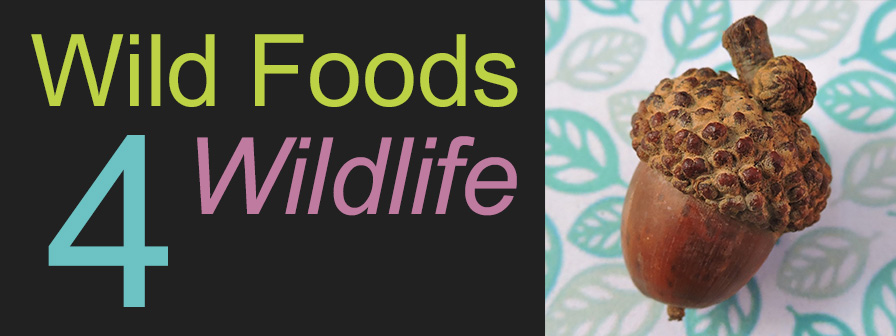Name: Wood Sorrel, Common Yellow
Botanical Name: Oxalis stricta
Form: wildflower
Parts Used: seeds, greens
Citation: Guenther, K. (2017, January 12) Common yellow wood sorrel as wildlife food [Web log post.] Retrieved: readers supply the date cited, from http://wildfoods4wildlife.com
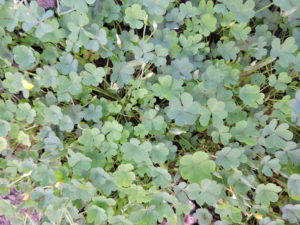
Getting Started
Wood sorrel is the typical yard “shamrock” you likely can find in your yard. Because of its three leaves, some might confuse it with clover. However, its flower is totally different than clover flowers—wood sorrel is a regular 5-petaled, yellow flower.
It is not high on either our Great Greens list (53rd) or our Super Seeds list (45th). But as I have stated elsewhere, I like to collect a wide variety and a large quantity of greens especially for the many cottontails at my local rehabbers’ facilities. It’s easy pickings in my yard, so I collect it. Though extraordinarily high in oxalic acid (it’s even in the name!), a little can be added as a garnish to rabbit salads with no harm.
Oxalidaceae (Wood sorrel Family)
Oxalis (Wood sorrel Genus)
| Common name | Virginia Oxalis Species | Origin | Rare Plant Status |
|---|---|---|---|
| red wood sorrel | O. articulata | non-native | not rare |
| creeping wood sorrel | O. corniculata | native | not rare |
| southern yellow wood sorrel | O. dillenii | native | not rare |
| slender wood sorrel | O. florida | native | not rare |
| great yellow wood sorrel | O. grandis | native | not rare |
| mountain wood sorrel | O. montana | native | yes, in some states (not Virginia) |
| common yellow wood sorrel | O. stricta | native | not rare |
| violet wood sorrel | O. violacea | native | yes, in some states (not Virginia) |

Key Features to Look For
In addition to the identification guide of your choice, here are a couple of features you should see on this plant:
- Shamrock leaves of three , folded slightly along the center line—the axis—of the leaf
- Low growing plants that grow in clumps or singly, usually no taller than about 6-9 inches
- Very thin, spaghetti-sized stems
- Bright yellow flowers with 5 petals
Risks
Plants in this genus are high in soluble oxalates. Read more about oxalates here.
About this Species
I can sometimes collect this whole plant as a green in abundance. Because it has roots that connect plants underground (rhizomes), it tends to grow in quantity in a small patch. Because of these roots, it is a hard plant to weed out, because the plant breaks off and the roots re-grow next year. But that is fine if you want a small perennial wood sorrel patch to harvest from!
Flower Description: 5 regular yellow petals, flowers bright yellow and ¼ to ½ inch in diameter (6-12mm).
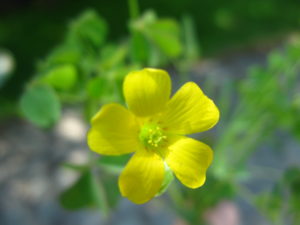
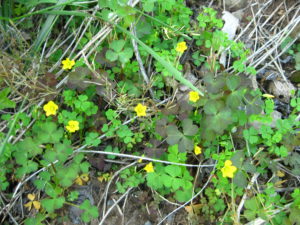
Leaf Description: Erect plants unusually less than 1 foot tall. Shamrock leaves of three with a fold going down the center line—the axis—of the leaf. Each of the 3 leaflets that makeup the leaf is heart shaped.
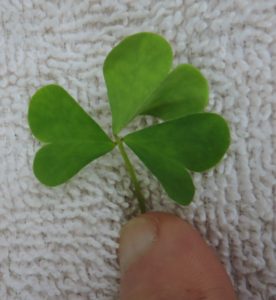
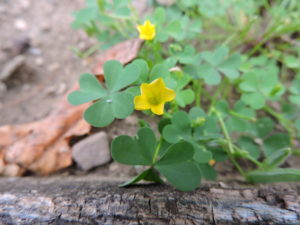
Seed/ Fruit Size: Seed develops inside long pointed, green seed pods that replace the flowers as they mature. Seed pods are about inch long (25mm). Wild edible forager folks refer to these as “sour cucumbers.”
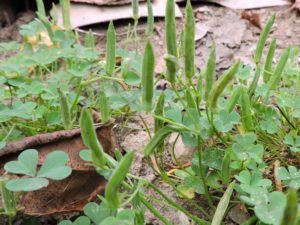
Harvest
| Jan | Feb | Mar | Apr | May | Jun | Jul | Aug | Sep | Oct | Nov | Dec | ||||||||||||||
|---|---|---|---|---|---|---|---|---|---|---|---|---|---|---|---|---|---|---|---|---|---|---|---|---|---|
| winter | winter | late winter | early spring | spring | late spring | early summer | summer | late summer | early fall | fall | late fall | ||||||||||||||
| greens | x | x | x | x | x | x | x | x | x | ||||||||||||||||
Does this lend itself as a good enrichment item? No, I don’t think so.
Harvesting Seed
You will see that there are a good number of animals that eat wood sorrel seed. But I don’t think it is practical to harvest as a collectable seed for rehab. The seeds are small, each seed pod contains a small quantity of seed, and when mature, the seed pods explode to forcefully disperse the seed away from the plant. So while it may be possible to collect a small handful of seed, I am not sure there is much to be gained from collecting wood sorrel seed as a food for rehab animals.
Harvesting Greens
You can pull up whole plants spring to fall. By leaving the roots attached, the greens will stay fresher longer in the refrigerator, up to 1 week.
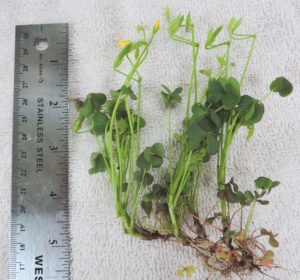
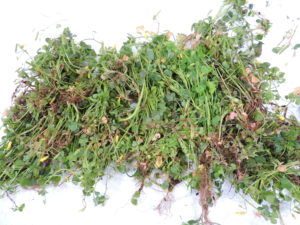
How to Store Prepared Greens: If you choose to, use a commercial vegetable cleaner or a ¼ cup (60 ml) of vinegar added to wash water as a cleaner. Submerge the plant material and swish it around to remove all dirt from leaves and roots. Rinse in clean water. Always wash greens; you never know what might be on them…like animal feces or urine. Place in a colander or salad spinner to drain, then layout a towel and spread the greens on the towel and roll up the towel. Unroll and transfer the damp greens to storage.
For storage, there are a couple of different possible container methods. If the greens will be used quickly within days, place the spun-and-towel-rolled damp greens to a 1 gallon zip-lock baggie with 12-15 holes cut in it to provide air and keep the greens from molding (or reuse commercial grape bags with holes). Label the bag with the plant name and which animals it should be used for. Keep container in the vegetable drawer of the refrigerator.
For storage longer than one week, use a rigid, lidded, airtight container. After washing and salad spinning the greens, place a paper towel in the bottom, then loosely fill with greens, but do not pack them in. Then lay a paper towel on top and put on lid. Keep container in the vegetable drawer of the refrigerator. Do not use if greens become moldy, slimy or dried out.
Many greens are very sensitive to exposure to ethylene gas, though greens themselves are low emitters of the gas. You may get longer quality by adding with a product that reduces free ethylene gas in the refrigerator. Greens are good until they become dry and crispy, fade in color, or become slimy or moldy. Read more about storing greens.
Other Species
The most likely plant to confuse wood sorrel with is black medick, which likes similar habitat, blooms about the same time, and also has yellow flowers and has 3 leaflets per leaf. But the flower on yellow clover is totally different and irregular with no obvious individual petals. The 3 leaflets of yellow clover do not have a fold down the middle of the leaf and the leaflets are not heart shaped.
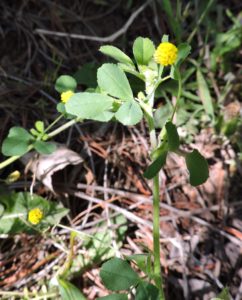
Rare Species in Virginia
There are no endangered/threatened wood sorrel species in Virginia.
Feed Wood Sorrel to:
wood sorrel | (Oxalis spp.) | greens |
|---|---|---|
 Caution: Sheep have been affected by the high levels of soluble oxalates of Oxalis greens when eaten in large quantities.(Burrows, G.E. & Tyrl, R.J., 2013) | ||
Cottontail, Eastern | Sylvilagus floridanus |
|
Dove, Ground | Columbina passerina |
|
Dove, Mourning | Zenaida macroura |
|
Bobwhite, Northern | Colinus virginianus |
|
Grouse, Ruffed | Bonasa umbellus |
|
wood sorrel | (Oxalis spp.) | seeds |
Dove, Ground | Columbina passerina |
|
Dove, Mourning | Zenaida macroura |
|
Jay, Blue | Cyanocitta cristata |
|
Junco, Dark-eyed | Junco hyemalis |
|
Lark, Horned | Eremophila alpestris |
|
Sparrow, American Tree | Spizella arborea |
|
Sparrow, Chipping | Spizella passerina |
|
Sparrow, Field | Spizella pusilla |
|
Sparrow, Grasshopper | Ammodramus savannarum |
|
Sparrow, Savannah | Passerculus sandwichensis |
|
Sparrow, Song | Melospiza melodia |
|
Sparrow, White-throated | Zonotrichia albicollis |
|
Bobwhite, Northern | Colinus virginianus |
|
Grouse, Ruffed | Bonasa umbellus |
|
Book References:
Burrows, G.E., Tyrl, R.J. (2013) Toxic Plants of North America, 2nd Edition, Oxford, U.K.: John Wiley & Sons, Inc.
Martin, A.C., Zim, H.S., Nelson, A.L. (1951). American Wildlife and Plants: A Guide to Wildlife Food Habits. New York: Dover Publications.
Scott, M. (2013). Songbird Diet Index. National Wildlife Rehabilitators Association, St. Cloud, MN.
Townsend, J. F. (2015, April) Rare Plants Natural Heritage Technical Report 15-10. (Unpublished Report) Richmond, Virginia: Virginia Department of Conservation and Recreation, Division of Natural Heritage.
On-line References:
USDA, NRCS. 2015. The PLANTS Database (http://plants.usda.gov, 4 February 2016). National Plant Data Team, Greensboro, NC 27401-4901 USA.
Virginia Botanical Associates. (Accessed February 2, 2016). Digital Atlas of the Virginia Flora (http://www.vaplantatlas.org). c/o Virginia Botanical Associates, Blacksburg.
